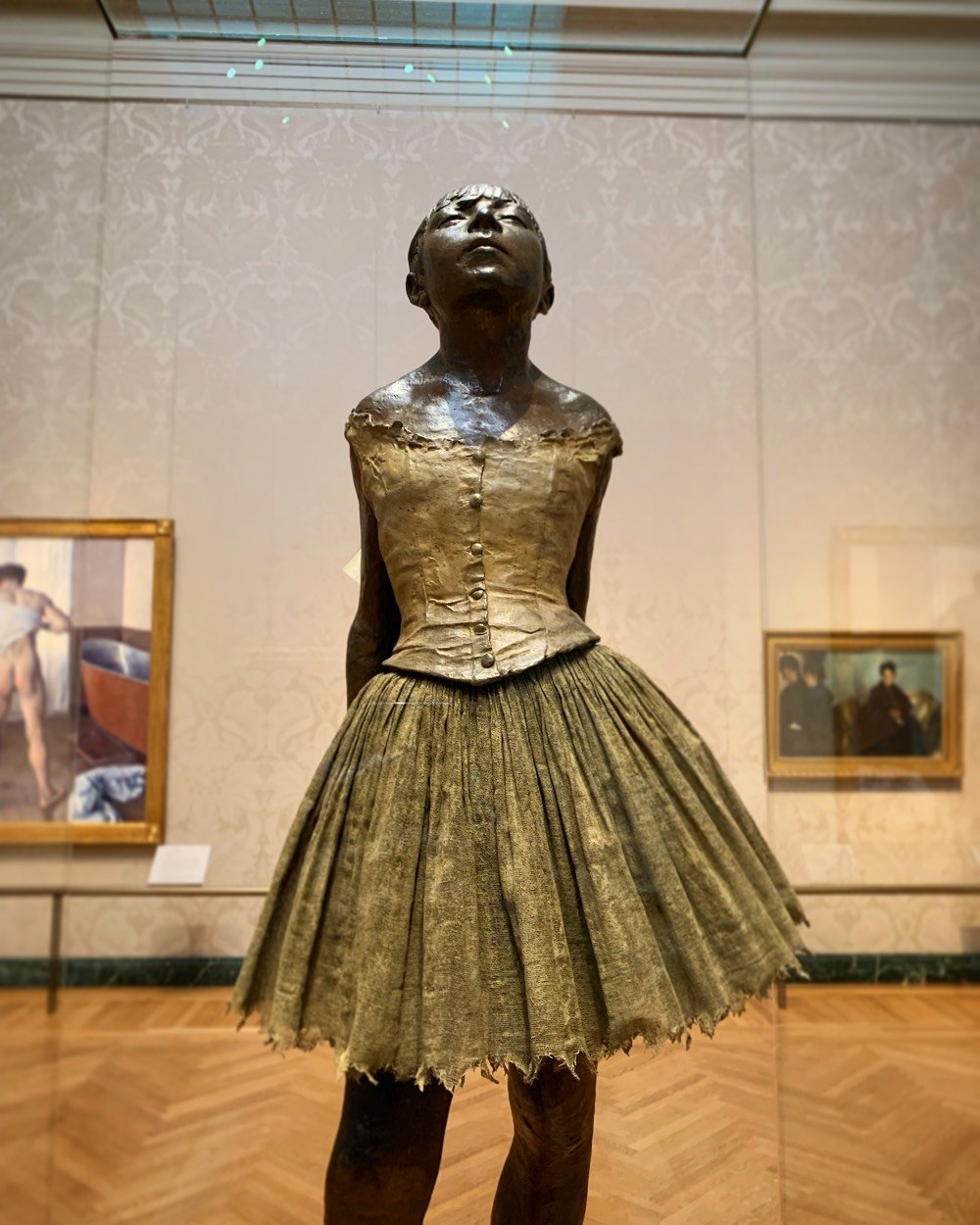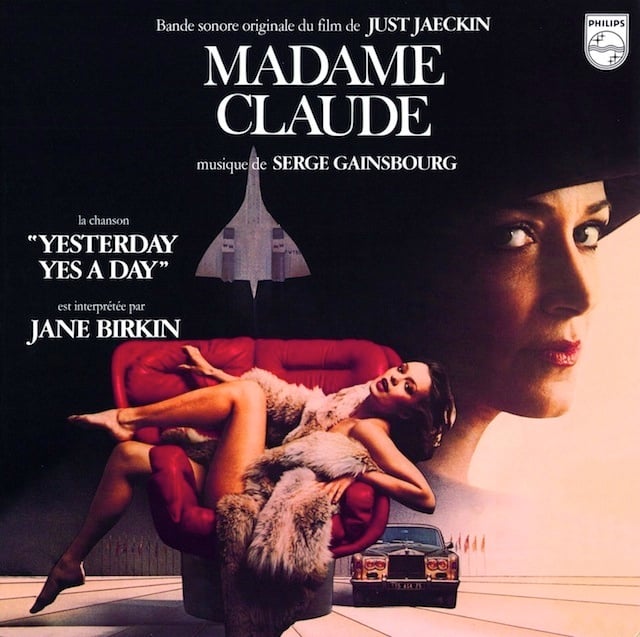This past weekend I was in Boston for some cultcha and went to The Museum of Fine Arts. Among several paintings, pastels, and drawings of dancers by Edgar Degas, a bronze casting of his sculpture La Petite Danseuse de Quatorze Ans caught my eye:

This is Degas’s largest surviving sculpture and the only one he titled and exhibited. The original wax version, a portrait of a young Belgian dancer named Marie van Goethem, was shown at the 1881 Impressionist exhibition in Paris. The wax was tinted to resemble flesh, she wore a wig of real hair, and was dressed in pink slippers and bodice in addition to a skirt and ribbon similar to those on this cast. The excessive naturalism of the work offended many viewers, but the critic J.K. Huysmans called it “the only really modern attempt that I know in sculpture.”
I’ve seen many representations of ballet dancers in Degas’ work over the years, but this time around was different because I had read Julia Wolkoff’s The Sordid Truth behind Degas’s Ballet Dancers last year.
The formerly upright ballet had taken on the role of unseemly cabaret; in Paris, its success was almost entirely predicated on lecherous social contracts. Sex work was a part of a ballerina’s reality, and the city’s grand opera house, the Palais Garnier, was designed with this in mind. A luxuriously appointed room located behind the stage, called the foyer de la danse, was a place where the dancers would warm up before performances. But it also served as a kind of men’s club, where abonnés — wealthy male subscribers to the opera — could conduct business, socialize, and proposition the ballerinas.
Young members-in-training of the ballet companies were called “petits rats” in reference to their often impoverished backgrounds. As Wolkoff observes of the subject of the sculpture:
Marie van Goethem was the “petit rat” who posed for the sculpture, and she likely engaged in the sexually predatory economy of the ballet world to survive. Van Goethem disappeared from the public eye shortly after the sculpture was completed; after being late to a rehearsal, the Paris Opera Ballet dismissed her. The teenager probably returned home to follow in the footsteps of her mother — a laundress and likely prostitute — and older sister, who was also a sex worker.
Here’s a Degas painting of an on-stage practice from the collection at the Met:

What might look at first glance like a depiction of the beauty of dance takes on a more sinister nature when you notice the men on the right side of the painting, perhaps a pair of wealthy subscribers getting a special preview of that night’s ballet and their choice of ballerinas. You might never look at another of Degas’ ballet paintings the same way again.

One of the world’s most famous madams, Madame Claude (real name: Fernande Grudet), has died at 92, leaving behind a colorful obituary in which it’s hard to discern what the real story was behind the mere maquerelle to the world’s most powerful men.
In 1975, the French tax authorities, who had begun taking an interest in Ms. Grudet’s business, estimated that she was taking in 100,000 to 140,000 francs a month. Her clients, whom she called “friends,” were a catalog of the rich and famous.
The soul of discretion in her heyday, Ms. Grudet became a heavy name-dropper when the time came to tell her life story, which she did in two memoirs: “Allo Oui, or the Memoirs of Madame Claude” (1975), written with Jacques Quoirez, the brother of her good friend Francoise Sagan and one of her testers; and “Madam,” published in 1994 under the name Claude Grudet.
By her account, the “friends” included John F. Kennedy, the shah of Iran, Muammar el-Qaddafi, Gianni Agnelli, Moshe Dayan, Marc Chagall, Rex Harrison and King Hussein of Jordan, who, she said, once told a Claude girl: “You and I are in the same business. We have to smile even when we don’t feel like it.”
High-end prostitutes see an uptick in business — for a few months anyway — during times of financial hardship and crisis.
Their clients were coming to them for a mix of escape and encouragement. As Jean, a New Yorker and a 35-year-old former paralegal turned “corporate escort” (her description) told me, “I had about two dozen men who started doubling their visits with me. They couldn’t face their wives, who were bitching about the fact they lost income. Men want to be men. All I did was make them feel like they could go back out there with their head up.”
Indeed, forty percent of encounters between high-end prostitutes don’t involve sex…like therapy with occasional benefits.
The economics of high-end prostitutes.
Unlike their low-end counterparts, high-end call girls are expected to supply some level of companionship, and often accompany clients to dinners or parties. Because a beautiful and intelligent woman inevitably has other job (and marriage) options, a very high wage is necessary to encourage them to forgo other opportunities, and risk arrest, disease and shame.
And escorts must spend a great deal maintaining their value without immediate compensation. Much time and money is spent on grooming: hair removal, expensive hair-cuts (one stylist I spoke to claims several of his clients are escorts, who spend at least $1,000 a month on extensions and colour) and regular exercise. Many women have had plastic surgery (particularly if they were once men) and maintain an expensive designer wardrobe. Frequent visits to the doctor are necessary to protect against sexually-transmitted diseases.
One of the side effects of the Eliot Spitzer situation is the discussion of prostitution happening in various places online by those with experience in or knowledge of that profession. Here are a few I’ve run across.
On the Freakonomics blog, an interview with a “high-end call girl” named Allie about the Spitzer affair.
Almost all of my clients are married. I would say easily over 90 percent. I’m not trying to justify this business, but these are men looking for companionship. They are generally not men that couldn’t have an affair [if they wanted to], but men who want this tryst with no stings attached. They’re men who want to keep their lives at home intact.
Susannah Breslin talks about her twin web projects, Letters from Johns and Letters from Working Girls and what light they could shed on Spitzer’s actions.
But one high-end call girl I spoke to about the Spitzer affair said there are lots of reasons a man in such a prominent position might seek high-stakes sex with a prostitute. Why not just have an affair, which probably wouldn’t have destroyed his career? She said that Spitzer, if he did use prostitutes, was probably one of those men for whom the payoff was the excitement of doing something really taboo. “What could be more taboo than going to an agency when you’re a crusader for all that is moral and good?” she theorized. “It’s only natural,” this call girl asserted, “that they’d hire a girl to get off.” She speculates that there was probably a “midlife crisis element” there too.
Former Hollywood madam Heidi Fleiss chimes in:
Look, it’s going to go on. You’re never going to stop prostitution. The way to do it is to regulate it. Clean it up a bit. Make it fair-fair for the girls, fair for the clients. At the end the government gets money out of it.
A Former Sex Worker’s Thoughts About Eliot Spitzer.
I’m a former sex worker. I still have many sex worker friends that are dear to me. Ones who both face all the risks of being a sex worker, but also fight for sex worker rights in public. They are at risk from the very policies of men like Spitzer. Eliot could have done something groundbreaking. He could have been a governor that dared to advocate for sex worker human rights. But he didn’t. Eliot persecuted sex workers. He made it easier for sex workers to be exploited, to be violated, to be stigmatized, to face discrimination, to face rape, assault and other crimes.
Sociologist Sudhir Venkatesh has done research on high-end sex workers in NYC and elsewhere. He explains how it works in this Slate article.
What high-end clients pay for may surprise you. For example, according to my ongoing interviews of several hundred sex workers, approximately 40 percent of trades in New York’s sex economy fail to include a physical act beyond light petting or kissing. No intercourse, no oral stimulation, etc. That’s one helluva conversation. But it’s what many clients want. Flush with cash, these elite men routinely turn their prostitute into a second partner or spouse. Over the course of a year, they will sometimes persuade the woman to take on a new identity, replete with a fake name, a fake job, a fake life history, and so on. They may want to have sex or they may simply want to be treated like King for a Day.
If you run across any similar links, send them along.
Very interesting paper on the economics of prostitution by Steven Levitt and Sudhir Venkatesh.
The transaction-level data we collected suggests that street prostitution yields an average wage of $27 per hour. Given the relatively limited hours that active prostitutes work, this generates less than $20,000 annually for a women working year round in prostitution. While the wage of a prostitute is four times greater than the non-prostitution earnings these women report (approximately $7 per hour), there are tremendous risks associated with life as a prostitute. According to our estimates, a woman working as a prostitute would expect an annual average of a dozen incidents of violence and 300 instances of unprotected sex.
The authors also noted that a prostitute was “more likely to have sex with a police officer than to get officially arrested by one”. (via marginal revolution)
Great SF Chronicle series on sex trafficking: Diary of a Sex Slave. The story centers around a young Korean woman who accrues massive credit card debt and then is sold into prostitution to pay it off.
The adults had us fooled when we were kids. Yes they did. And I’m not talking about the Easter bunny or Santa Claus or the booger man. I’m talking about the flea circus. I think I was probably 16 or 17 years old before I figured out that there weren’t actually any fleas in a flea circus. It was all just a trick, brought upon us by adults and Tom & Jerry cartoons.








Stay Connected